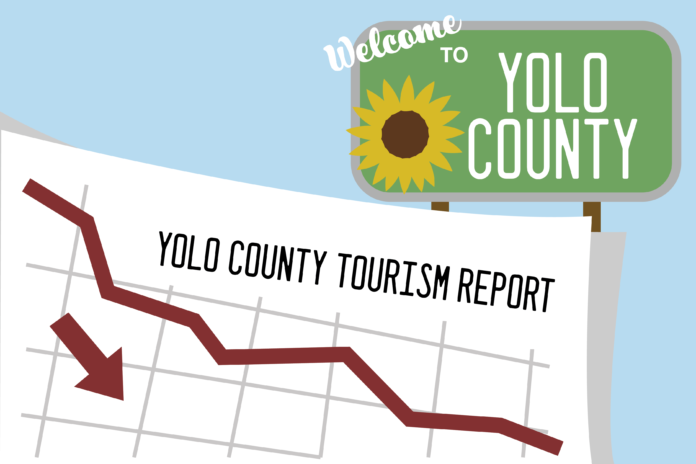Decline in travel spending, jobs impacted
A recent report from Visit California showed the economic impact of tourism from 2010–2019 across various regions of California, including Yolo County. The results from this report, however, do not include the forecasted impact of the COVID-19 pandemic on tourism across Yolo County.
According to the report, travel spending grew steadily during the past decade, from $324,036,782.26 in 2010 to $454,322,463.11 in 2019. The tourism expenditure helped support 1.18 million jobs across California, according to the report.
Despite the increased jobs from the increase in travel spending in 2019, the COVID-19 pandemic has already had an impact on numerous industries across California, with millions filing for unemployment across the country.
Terry Selk, the executive director of Visit Yolo, noted the impact on the tourism industry.
Many programs and services that residents benefit from are funded by “tourism dollars on every level,” Selk highlighted.
“Some hotels have had to close indefinitely while others have significantly needed to reduce staffing due to exceptionally low occupancy rates, in the single digits,” Selk said via email. “In Davis, without campus activity, the lodging properties, restaurants and other services frequented by students and their parents have suffered.”
Another report from Tourism Economics forecasted the impact that coronavirus would have on tourism across California. The economic situation could be subject to change though, the report noted.
The report also highlighted the decline in travel spending compared to prior months. For instance, in April 2020 there was predicted to be a 81% decrease in travel spending compared to April 2019 and a 74% decrease in July 2020 compared to July 2019.
Additionally, the report predicts the impact on jobs across the state by creating a “mitigated downturn” scenario. In this, “a scenario model was run to assess the potential gains of a more tempered downturn beginning in June, resulting in a net gain of $14.2 billion in visitor spending relative to the baseline scenario,” the report reads.
This scenario assumes a range of efforts being implemented to help reduce the impact on the tourism industry. According to the mitigated downturn scenario, there will be a $57.9 billion decrease in tourism revenue, compared to the baseline $72.1 billion decrease.
Furthermore, if more measures are implemented to help promote tourism, the number of travel related jobs affected will decrease.
For example, in June 2020, there are predicted to be 608,000 “travel-related jobs” affected by COVID-19 and 363,000 in October 2020. Nevertheless, with the mitigated downturn scenario, 537,000 will be affected in June and 199,000 in October.
Even after the pandemic is over, some businesses will not be able to recover, according to Selk.
“Many of the smaller businesses who have had to shut their doors may never be able to recover from the economic impact,” Selk said via email. “Some operations with small square footage may not be able to generate enough volume of business to be profitable. Restaurants run on very small margins and rely on the ability to serve many customers over the course of a day to be able to make payroll, rent and other necessary operating expenses.”
Businesses such as hotels may also continue to be affected, as they are dependent, to a certain extent, on a group or corporate business, according to Selk. Restrictions on gathering sizes will affect events, which create higher occupancy in establishments such as boutique hotels and vacation rental properties across the county.
“The normal of the future will likely not be the normal we knew,” Selk said via email. “Travel sentiment and trip decisions will be greatly influenced by many factors taken for granted previously such as clean and sanitized hotel rooms, social distancing spacing.”
On April 9, 2020, the California Travel Industry Coalition addressed a letter to Gov. Gavin Newsom with suggested measures to help support the travel and tourism industry.
“As you continue to make critical decisions to prepare California for the peak of COVID-19 and ensure that we are able to meet this moment, we urge you to not lose sight of the economic hardships businesses are facing, especially those in the travel and tourism industry,” the letter read.
There could be an increase in demand for travel, according to Selk.
“Indicators reveal that there is pent up demand for travel but execution will return in waves starting with local and regional, followed by longer haul US and then international,” Selk said via email. “Yolo County is positioned ideally for the first wave as it possesses many of the current aspects of which travelers will seek – wide open spaces, fresh air, low city congestion.”
According to the letter from the California Travel Industry Coalition, one such way to help communities who have been affected by “the potential loss of the Transient Occupancy Tax revenue base” is a “one-time emergency stimulus fund.”
Selk noted that the general public can help support tourism during this time by supporting local businesses and welcoming those who are visiting Yolo County from other areas.
“When it is appropriate for travelers to cross county borders, invite your friends and family to come experience YOUR Yolo County, showing off what makes this a special place to live, work and play,” Selk said via email.
Written by: Shraddha Jhingan — city@theaggie.org




